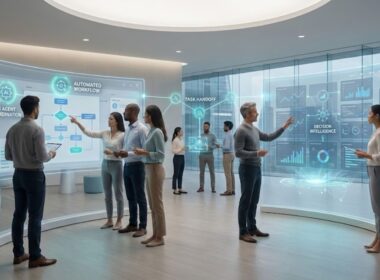A Guide to Enterprise Design Thinking
According to research by Forrester, using IBM’s Enterprise Design Thinking framework, organizations reported a 75% reduction in initial design and alignment time. Additionally, project teams could design and execute projects twice as fast. But what is Enterprise Design Thinking (EDT) all about?
Think of EDT as the evolution of classic Design Thinking. While the original approach excels in smaller projects, it can struggle to scale up for the complex challenges faced by enterprise-level projects.
EDT maintains the core strengths of Design Thinking and scales them at the enterprise level. In this blog, we will discuss the principles and critical elements of Enterprise Design Thinking and how it can help your business.
What is Enterprise Design Thinking?
Enterprise Design Thinking (EDT) is the evolution of classic Design Thinking. IBM specifically developed it to address the challenges of large-scale projects in today’s complex and modern business environment.
Here’s a breakdown of what makes EDT unique:
Focus on User Outcomes: Similar to traditional Design Thinking, EDT is human-centric. It focuses on understanding customer needs and designing solutions with positive user outcomes at the heart.
Scalability and Speed: A key differentiator is its focus on scalability and speed. It helps everyone collaborate effectively, even across departments, so that you can brainstorm and innovate quickly.
Iterative Process: Like classic Design Thinking, EDT is also an iterative process. Teams continuously gather user feedback, refine ideas, and develop solutions through cycles of understanding, exploration, prototyping, and validation.
Now, let’s examine the core principles of EDT.
Also Read: Understanding Design Thinking in Product Management
Core Principles: The Guiding Light
Enterprise Design Thinking (EDT) is anchored in three core principles that act as your guiding light throughout the process.
A Focus on User Outcomes
This principle puts users at the center of everything you do. This means understanding their needs, wants, and pain points. By focusing on user outcomes, you ensure the solutions you create truly solve problems and deliver value to the people who matter most.
It’s not about creating the most feature-rich product or the one with the most advanced bells and whistles. It’s all about repeatedly asking one question: How will this solution truly help the end user?
Restless Reinvention
Great ideas are rarely born perfect. EDT embraces the concept of “restless reinvention,” which means continuously improving and iterating on your ideas based on user feedback.
This isn’t about waiting until everything is perfect before moving forward. Instead, you develop prototypes, test them with real users, and gather their insights. This feedback loop allows you to refine your ideas, identify areas for improvement, and ultimately create solutions that are truly effective.
Diverse Empowered Teams
EDT recognizes the power of bringing together people from various backgrounds and disciplines. By assembling teams with a range of skills and perspectives, you ensure you consider all angles of a problem and come up with well-rounded solutions.
With these principles in mind, it’s time to talk about the heart of EDT—the innovative loop that keeps the wheel moving forward.
The Loop: A Framework for Constant Innovation
Enterprise Design Thinking (EDT) does not follow a linear approach and favors something more dynamic: The Loop. Imagine it as a never-ending cycle that constantly helps you move forward. Here, you’ll observe, reflect, make, and repeat.
Observe: The Loop places user research at the center of everything you do. This can involve user interviews, surveys, or ethnographic research. Gather information about your target audience and gain a deep understanding of their needs and challenges.
Reflect: Analyze the information you’ve collected and take a step back to reflect on what you’ve learned. What are the key user insights? How can you translate those insights into actionable design decisions?
Make: This is where you put your ideas into action. Develop low-fidelity prototypes, test them with users, and get their feedback.
The beauty of The Loop is that it keeps everyone in your organization focused on the user. Cross-functional teams composed of designers, developers, engineers, and marketing professionals work together throughout the process. This breakdown of departmental silos builds empathy and ensures everyone understands the user’s perspective.
With its innovative Design Thinking services, Codewave can help you efficiently navigate ‘The Loop’ and provide the guidance needed to keep your team aligned and focused.
Did you get a grasp on The Loop? Great! Let’s talk about the tools that bring these concepts to life.
The Keys: Putting the Power in Your Hands
The Loop provides the overall framework for Enterprise Design Thinking (EDT), but there are specific components that help you navigate this ongoing cycle effectively. Let’s look at the three key components that keep your EDT projects on track and help deliver results:
Hills
Hills are clear, user-centric goals that set the direction for your project. Each Hill follows a specific format to ensure user-centricity. Think of it in three parts:
Who: This defines the target user for the Hill. Who will benefit from this ideal outcome?
What: This outlines the specific action or capability the user will gain. What will the user be able to do thanks to this Hill?
Wow: This captures the emotional benefit for the user. How will this Hill make the user’s life better or easier?
These goals should be specific, measurable, achievable, relevant, and time-bound (SMART). By establishing Hills at the outset, everyone on your team is aligned on what success looks like.
IBM recommends limiting yourself to no more than three major Hills per project, alongside a technical foundation objective. This keeps your project focused and achievable.
Playbooks
Communication is critical for any successful project, and EDT is no exception. Playbacks are iterative feedback sessions designed to keep your team on the same page and ensure your project stays agile.
These user-centric sessions happen at key milestones throughout the project. They present a chance to showcase progress, test prototypes with stakeholders, and gather valuable user insights. Early Playbooks, especially those focused on initial prototypes, ensure your Hills hit the mark with your target users. By presenting your ideas early and often, you can course-correct before investing too much time and resources.
Sponsor Users
Who better to understand your users than real users themselves? Sponsor users are selected from real or intended user group. They actively participate throughout the design and development process.
These users provide invaluable feedback on prototypes, helping you identify usability issues and refine your solutions. Integrating sponsor users throughout The Loop ensures you’re constantly getting real-world insights.
By integrating Hills, Playbacks, and Sponsor Users into your EDT, you’ll be well-equipped to navigate The Loop and achieve significant gains.
All these frameworks and principles are well and good, but what’s the payoff?
Benefits of Enterprise Design Thinking
We’ve covered the what and the how of Enterprise Design Thinking (EDT). Now, let’s understand the why. Enterprise design thinking offers a strong set of advantages for organizations:
Boosts Innovation: Enterprise design thinking encourages creative problem-solving and experimentation. It breaks down silos between departments, fostering cross-department collaboration. This cross-functional teamwork leads to a wider range of perspectives and a greater chance of developing groundbreaking products and services.
Improved Efficiency: The iterative nature of EDT means you catch problems early on before they snowball into major issues. This reduces the need for costly rework and delays, leading to a more efficient use of resources.
Enhanced Customer Centricity: By prioritizing user needs and understanding their problems through empathy-building exercises, businesses can develop solutions that truly resonate with their target audience. This approach leads to increased customer satisfaction and loyalty.
Focuses on Real-World Problems: EDT tackles real-world problems, not just theoretical ones. By involving real users (sponsor users) and industry experts throughout the process, you gain valuable practical insights. This ensures the solutions you develop are actually effective in the real world.
While the benefits of EDT are compelling, achieving them is not without its challenges. Codewave’s expertise in design-led tech development can help businesses overcome these hurdles and realize the full potential of EDT.
Feeling curious about how EDT stacks up against other frameworks? Let’s draw some comparisons and see what sets it apart.
Comparing Methodologies: IBM vs. IDEO
While IDEO’s design thinking framework is valuable, IBM recognized the need for adjustments to handle the complexities of large projects. Here’s how they adapted it:
Balancing Human Connection and Technology: IDEO’s design thinking process excels at fostering creativity and generating ideas through techniques like brainstorming.
Enterprise design thinking acknowledges the importance of these elements. However, it also recognizes the need for a more structured approach to managing enterprise-level projects.
Speed and Scale: IBM streamlined the process for faster iteration and collaboration across dispersed teams, which is crucial for large organizations.
Structured Approach for Ambiguity: At the outset, enterprise problems can be multifaceted and unclear. EDT tackles this by emphasizing a clear definition of the core challenge upfront. This provides a solid foundation for user research and ideation.
Involving Stakeholders: Stakeholders can make or break a project. EDT identifies them early on and brings them into the design process from the get-go. This ensures their needs and perspectives are considered throughout, leading to solutions with greater buy-in and reduced risk of eventual roadblocks.
The Future of Innovation: Designed with Users in Mind
Enterprise design thinking isn’t just a methodology; it’s a transformative approach to innovation. By prioritizing user needs, improving collaboration, and embracing continuous improvement, you can equip your organization to conquer any challenge.
EDT goes beyond traditional Design Thinking by incorporating features that specifically address the challenges of scale. The Loop, Playbacks, Hills, and Sponsor Users – all these work together to keep everyone (even big, spread-out teams) on the same page, focused on achieving user-centric goals.
Ready to implement EDT in your organization?
Partner with Codewave, an expert in Design Thinking-led digital transformation services. Our team can help you navigate The Loop, develop user-centric solutions, and achieve breakthrough results. Contact us today to learn more!
Codewave is a design thinking led digital transformation company enabling organisations with playful innovation using AI & ML, IoT & Edge, AR, VR, Cloud, Blockchain, and Data.







